

Gold barb. This species may be confused with: golden barb (P. gelius) or gold-finned barb (P. sachsii).

Description[edit] Adults of this species have highly arched backs and a short pair of barbels on the upper jaw at the corners of the mouth. The back is light to reddish brown, the sides are metallic green or yellow-green, with a brassy or golden sheen below. The belly is whitish, turning orange-red in males at mating time. Females can be distinguished by their dull colors and their overall bulk. This species can reach a length of 7 centimetres (2.8 in) TL though most do not exceed 3.5 centimetres (1.4 in) SL.[3] Diet[edit] Fish Profile for Bala Shark, Silver Shark, Tricolor Shark (Balantiocheilos melanopterus, Barbus melanopterus, Puntius melanopterus)
Discus 101 Beginners Guide - Discus Fish Guide. Rasbora sarawakensis - Seriously Fish. Harlequin (Trigonostigma heteromorpha) - Seriously Fish. SynonymsTop ↑ Rasbora heteromorpha Duncker, 1904 Classification Order: Cypriniformes Family: Cyprinidae Distribution Type locality is ‘Kuala Lumpur, Selangor, Malaysia’, but this species is usually quoted as being native to southern Thailand, Peninsular Malaysia, Singapore, and the Greater Sunda islands of Borneo and Sumatra.
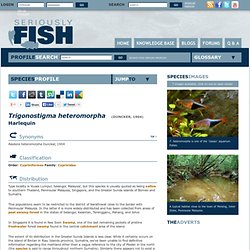
Thai populations seem to be restricted to the district of Narathiwat close to the border with Peninsular Malaysia. In Singapore it is found in Nee Soon Swamp, one of the last remaining pockets of pristine freshwater forest swamp found in the central catchment area of the island. The extent of its distribution in the Greater Sunda Islands is less clear. The fish are known to vary somewhat depending on collection locality, with those collected from Johor and southern Thailand having an overall smaller, slimmer appearance than the Singapore and Sunda Island populations (see ‘Notes’). Scissor-tail rasbora.
The scissortail rasbora is the common name for a number of species freshwater aquarium fish that belongs to the rasbora family.
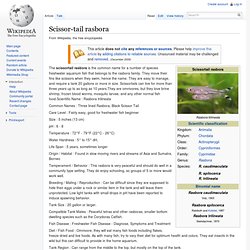
They move their fins like scissors when they swim, hence the name. They are easy to manage, and require a tank 20 gallons or more in size. Scissortails can live for more than three years up to as long as 10 years.They are omnivores, but they love brine shrimp, frozen blood worms, mosquito larvae, and any other normal fish food.Scientific Name : Rasbora trilineata Common Names : Three lined Rasbora, Black Scissor Tail.
Scissortail Rasbora (Rasbora trilineata) - Seriously Fish. Scissortail Rasbora (Rasbora trilineata) - Seriously Fish. Google Image Result for. Lyretail Killi (Aphyosemion australe) - Seriously Fish. Classification Order: Cyprinodontiformes Family: Nothobranchiidae Distribution Described from ‘Cap Gentil’, now known as Cape Lopez, close to the mouth of the Ogooué River, Gabon and is distributed in lowland areas along much of the country’s coastline plus that of Congo which borders Gabon to the south.
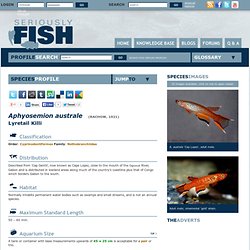
Nothobranchius rachovii. Introduction[edit] Nothobranchius rachovii, or the bluefin notho, (Ahl, 1926) is a species of freshwater annual killifish from Mozambique and South Africa.[1] It can grow up to 6 cm (2.4").[2] It is popular among killifish enthusiasts, who raise them from eggs in aquaria.

Variants[edit] Aside from the typical orange and blue variant, there is Nothobranchius rachovii KNP Black, which has much darker colors, and was collected from the wild in Kruger National Park, South Africa in 1984,[3] and Nothobranchius rachovii var. Red, which has a red head with turquoise highlights.[4] The females of all varieties are more neutrally colored. In the Aquarium[edit] Pearl Gourami (Trichopodus leerii) - Seriously Fish. Snakeskin Gourami (Trichopodus pectoralis) - Seriously Fish.
Snakeskin Gourami Care And Profile - Trichogaster Pectoralis. Food and feeding This Gourami will accept all foods offered.
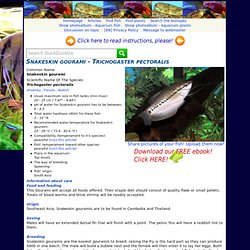
Their staple diet should consist of quality flake or small pellets. Treats of blood worms and brine shrimp will be readily accepted. Origin Southeast Asia; Snakeskin gouramis are to be found in Cambodia and Thailand. Sexing Males will have an extended dorsal fin that will finish with a point. The pelvic fins will have a reddish tint to them. Breeding Snakeskin gouramis are the easiest gouramis to breed; raising the fry is the hard part as they can produce 5000 in one batch.
Lifespan The expected life span for Trichogaster pectoralis is 3-5 years. Short description Trichogaster pectoralis need a lot of room, only keep them in a large aquarium. Pictures Thanks to Sayer for the picture! Pearl Gourami Care And Profile - Trichogaster Leeri. The Pearl gourami requires a medium to large tank with lots of plants and gentle filtration.
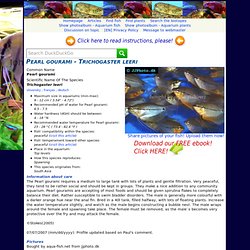
Very peaceful, they tend to be rather social and should be kept in groups. They make a nice addition to any community aquarium. Pearl gouramis are accepting of most foods and should be given spirulina flakes to completely balance their diet. Rather susceptible to swim bladder disorders. The male is generally more colourful with a darker orange hue near the anal fin. Banded Rainbowfish (Melanotaenia trifasciata) - Seriously Fish.
Lake Tebera Rainbowfish (Melanotaenia herbertaxelrodi) - Seriously Fish. Boesemani Rainbow. Overview The Boesemani Rainbow creates a colorful centerpiece for any freshwater home aquarium.
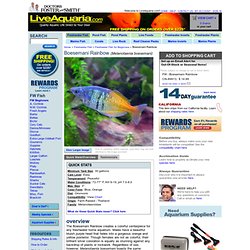
Males have a beautiful bluish purple head that fades into a gorgeous orange and yellow posterior. Though females are not as colorful, their brilliant silver coloration is equally as stunning against any backdrop of plants or rockwork. Regardless of sex, however, Melanotaenia boesemani boasts the same distinct characteristics as other Rainbowfish, including large eyes, a deeply forked mouth, and dual dorsal fins. Like many members of the Melanotaeniidae family, the Boesemani Rainbow also boasts the characteristic blackish-silver band of scales running laterally from gill to tail. This peaceful Rainbow is a schooling fish that does best in a planted aquarium with plenty of room to swim. An egg layer, Melanotaenia boesemani spawns on moss throughout the course of several days.
Although Boesemani Rainbows have large mouths, their throats tend to be narrow. White Cloud Mountain Minnow - Tanichthys albonubes. The white cloud mountain minnow is an extremely hardy fish that can withstand a wide range of temperatures.
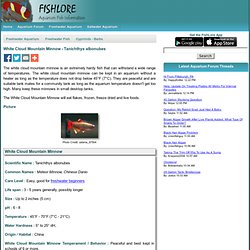
The white cloud mountain minnow can be kept in an aquarium without a heater as long as the temperature does not drop below 45°F (7°C). They are peaceful and are suitable tank mates for a community tank as long as the aquarium temperature doesn't get too high. Many keep these minnows in small desktop tanks. The White Cloud Mountain Minnow will eat flakes, frozen, freeze dried and live foods. Golden White Cloud Mountain Minnow. Overview The Golden White Cloud is a striking color variation of the White Cloud Mountain Minnow.
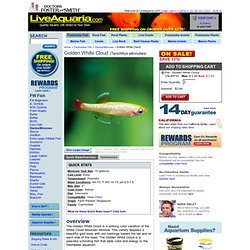
This variety displays a beautiful gold body with red markings toward the tail and on each side of the head. Tanichthys albonubes (White Cloud Mountain Minnow. SynonymsTop ↑ Aphyocypris pooni Herre, 1939 Etymology Tanichthys: named for Chinese boy scout leader Tan Kan Fei, who first collected the type species, plus the Greek ἰχθύς (ichthus), meaning ‘fish’. albonubes: from the Latin albus, meaning ‘white’, and nubes, meaning ‘cloud’, in reference to the species’ type locality (see ‘Distribution’).
Long Fin White Cloud. Glowlight Danio. Overview The Glowlight Danio is a brightly colored and showy cousin of the popular Zebra Danio. A relative newcomer to the aquarium hobby, this beautiful fish is adorned with bars, stripes, and spots in radiant green, gold, red, and turquoise. Danio choprae (Glowlight Danio. SynonymsTop ↑ Brachydanio choprai (Hora, 1928); Danio choprai Hora, 1928 Etymology Danio: from Dhani, a Bengalese vernacular term for small, minnow-like cyprinids. choprae: named for Dr.
B. Classification. Danio choprae (Glowlight Danio. Puntius padamya - The Free Freshwater and Saltwater Aquarium Encyclopedia Anyone Can Edit - The Aquarium Wiki. Hemigrammus erythrozonus. H. erythrozonus is a medium sized tetra growing to 4 to 5 cm (1.6 to 2 inches), notably larger than both neon and cardinal tetras. It has a life span of two to four years when kept in good conditions. In the wild, the fish eats aquatic insect larvae.[1] In the aquarium[edit] H. erythrozonus is readily available and usually inexpensive. [citation needed] Golden and albino varieties are also sold.
Water conditions[edit] Red-Lined Torpedo Barb - Puntius denisonii. In the wild, these fish inhabit fast-flowing freshwater streams and rivers in India. Puntius denisonii, formerly known as Barbus denisonii, were initially scarce in UK aquatic stores and came with a hefty price tag. They are now becoming more widely available. As a shoaling fish, they are happier when kept with others (preferably in groups of 4-6) and prefer a larger tank, 200 L or up with plenty of swimming space. Puntius denisonii - The Free Freshwater and Saltwater Aquarium Encyclopedia Anyone Can Edit - The Aquarium Wiki.
Red-tailed Tinfoil Barb (Barbonymus altus) - Seriously Fish. Tinfoil barb (Barbonymus schwanenfeldii) - Seriously Fish. Buenos Aires tetra. The Buenos Aires tetra (Hyphessobrycon anisitsi) is a tropical fish from South America. Buenos Aires Tetra (Hyphessobrycon anisitsi) - Seriously Fish. Bleeding Heart Tetra (Hyphessobrycon erythrostigma) - Seriously Fish. SynonymsTop ↑ Hemigrammus erythrostigma Fowler, 1943; Hyphessobrycon rubrostigma Hoedeman, 1956. Hyphessobrycon erythrostigma. The bleeding heart tetra, Hyphessobrycon erythrostigma is a peaceful mid-dwelling community fish in the aquarium.
It grows to the size of 64mm and lives about five years. Red Phantom Tetra Hyphessobrycon sweglesi aquarium tropical fish from Tropical Fish and Aquariums. The Red Phantom originates from the Orinoco River basin in South America. It was formerly known by the scientific name Megalamphodus sweglesi. The Red Phantom is very similar to the Black Phantom, even though it does not come from the same area. Bloodfin Tetra Aphyocharax anisitsi aquarium tropical fish from Tropical Fish and Aquariums. The Bloodfin Tetra originates from the Parana River basin of Argentina in South America. They are also known as the Glass Bloodfin, the Red-finned Characin, the Red-finned Tetra and the Argentine Bloodfin.
They are quite easy to keep. The body is translucent while the fins, especially the tail and lower fins, are red. Head-and-tail light Tetra (Hemigrammus ocellifer) - Seriously Fish. Serpae Tetra Hyphessobrycon serpae aquarium tropical fish from Tropical Fish and Aquariums.